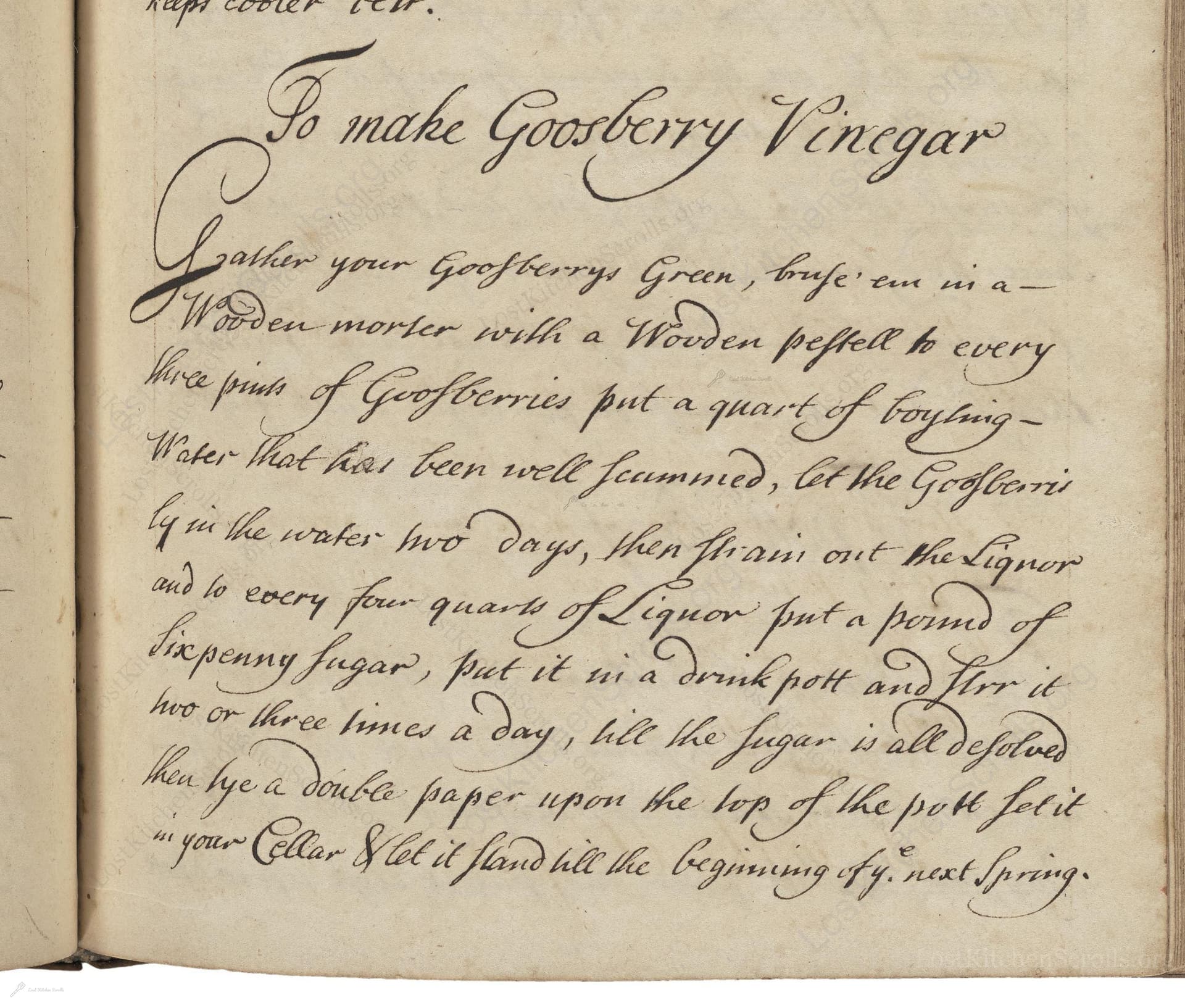To Make Goosberry Vinegar
From the treasured pages of Various Cookeries
Unknown Author

To Make Goosberry Vinegar
"Gather your Goosberrys Green, bruse 'em in a- Wooden morter with a Wooden pestell to every three pints of Goosberries put a quart of boyling- Water that has been well scumm'd, let the Goosberris ly in the water two days, then strain out the Liquor and to every four quarts of Liquor put a pound of sixpenny sugar, put it in a drink pott and stirr it two or three times a day, till the sugar is all desolv'd then tye a double paper upon the top of the pott set it in your Cellar & let it stand till the beginning of ye next Spring."
Note on the Original Text
The recipe is written in characteristic late 17th-century English, with idiosyncratic spelling—'Goosberrys' for 'gooseberries,' 'bruse' for 'bruise,' and 'boyling' for 'boiling.' Directions are conversational, assuming the reader's familiarity with general kitchen processes. Quantities are listed by volume, as was typical before the widespread use of precise scales, and utensils are emphasized for quality (wooden rather than metal). The timing is given with reference to seasons, not calendar days, which was common practice.

Title
Various Cookeries (1690)
You can also click the book image above to peruse the original tome
Writer
Unknown
Era
1690
Publisher
Unknown
Background
A delightful glimpse into late 17th-century kitchens, this book brims with recipes, methods, and culinary wisdom passed down through generations, capturing the essence of historical gastronomy.
Kindly made available by
Folger Shakespeare Library
This gooseberry vinegar recipe hails from the late 1600s in England, a period teeming with kitchen innovation and home fermentation. Vinegars were not only used as culinary condiments but also valued for their supposed medicinal virtues. Gooseberries, abundant in Northern Europe and the British Isles, offered a seasonal tartness that made them ideal for such preserves. Household manuals from this era often included instructions for making vinegars, wines, and conserves from various fruits. The process was regarded as both an act of thrift and culinary resourcefulness, maximizing summer's bounty for year-round usage.

The original preparation would have employed a wooden mortar and pestle, essential for crushing gooseberries without imparting off flavors from metal implements. Liquids were poured and left to macerate in large ceramic or stoneware pots—sometimes glass—while straining was done using cloth or fine sieves. The vessels were covered with oiled or waxed paper (or cloth) to keep out dust and insects during the long fermentation in cool, underground cellars.
Prep Time
20 mins
Cook Time
0 mins
Servings
40
We've done our best to adapt this historical recipe for modern kitchens, but some details may still need refinement. We warmly welcome feedback from fellow cooks and culinary historians — your insights support the entire community!
Ingredients
- 3.3 lbs green (unripe) gooseberries
- 1 pint (20 fl oz) freshly boiled water
- 8.8 oz white granulated sugar (per 2 quarts strained liquid)
- Clean muslin or cheesecloth (for straining)
- Parchment paper or clean cloth (for covering)
Instructions
- Begin by gathering green (unripe) gooseberries, about 3.3 lbs.
- Bruise them gently using a wooden pestle and mortar, taking care not to crush the seeds too vigorously, as this may impart bitterness.
- For each 3.3 lbs of gooseberries, pour over 1 pint (20 fl oz) of freshly boiled water that has been skimmed to remove impurities.
- Allow the mixture to sit for two days at room temperature.
- Afterward, strain off the liquid, pressing out as much as possible through muslin or cheesecloth.
- For every 2 quarts of this liquid, add 8.8 oz of white granulated sugar.
- Stir the mixture two to three times daily until the sugar is fully dissolved.
- Pour into a large, clean glass or ceramic container.
- Cover with a double layer of parchment or clean cloth fastened with twine or elastic.
- Place the container in a cool cellar or dark, cool spot and leave undisturbed until the beginning of the following spring (roughly 6–10 months).
- Decant and bottle the finished vinegar.
Estimated Calories
10 per serving
Cooking Estimates
You will spend about 20 minutes preparing and bruising the gooseberries, then wait two days for steeping and 6–10 months for fermentation. There is no cooking time, just prep and waiting.
As noted above, we have made our best effort to translate and adapt this historical recipe for modern kitchens, taking into account ingredients nowadays, cooking techniques, measurements, and so on. However, historical recipes often contain assumptions that require interpretation.
We'd love for anyone to help improve these adaptations. Community contributions are highly welcome. If you have suggestions, corrections, or cooking tips based on your experience with this recipe, please share them below.
Join the Discussion
Rate This Recipe
Dietary Preference
Main Ingredients

Den Bockfisch In Einer Fleisch Suppen Zu Kochen
This recipe hails from a German manuscript cookbook compiled in 1696, a time whe...

Die Grieß Nudlen Zumachen
This recipe comes from a rather mysterious manuscript cookbook, penned anonymous...

Ein Boudain
This recipe comes from an anonymous German-language manuscript cookbook from 169...

Ein Gesaltzen Citroni
This recipe, dating from 1696, comes from an extensive anonymous German cookbook...
Browse our complete collection of time-honored recipes



